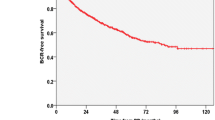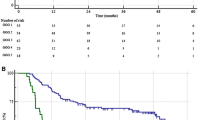Abstract
Purpose
We aimed to evaluate the impact of the primary Gleason pattern on biochemical recurrence-free survival (RFS) after radical prostatectomy (RP) in a single-center cohort of patients with Gleason 7 tumors.
Materials and methods
From 1998 to 2008, 2,239 consecutive patients underwent RP for a localized prostate cancer. A total of 1,248 patients with Gleason score (GS) 7 cancers were included. Follow-up was standardized for all patients and recorded into a prospective database. Median postoperative follow-up was 23.4 months. Biochemical recurrence was defined by prostate-specific antigen level > 0.2 ng/ml.
Results
In all, 721 patients (57.8%) had a final GS of 3 + 4 and 527 (42.2%) of 4 + 3. Patients with GS 4 + 3 had a significantly higher risk of biochemical progression than those with GS 3 + 4 (P < 0.001). The 3- and 5-year biochemical RFS for Gleason score 3 + 4 cancers was 84.6 and 76.4%, respectively, versus 69.9 and 61.1% in Gleason score 4 + 3 cancers. Multivariate analysis showed that the primary Gleason remained statistically predictive for PSA failure (P = 0.018). When analysis was stratified by both pathologic stage and margin status, predictive value of primary Gleason was significant in pT2R0, pT3-4R0, and pT3-4R1 cancers, whereas survival curves were not statistically different in pT2R1 cancers (P = 0.672).
Conclusion
Primary Gleason 4 pattern is an independent predictor for PSA failure. Analysis of Gleason patterns provides clinically relevant prognostic information, which may assist in the management of patients with Gleason score 7 cancers.


Similar content being viewed by others
Abbreviations
- Pca:
-
prostate cancer
- PSA:
-
prostatic-specific antigen
- RFS:
-
recurrence-free survival
- RP:
-
radical prostatectomy
- GS:
-
Gleason score
- SM:
-
surgical margin
- ECE:
-
extracapsular extension
- SVI:
-
seminal vesicle invasion
- R:
-
margin status (R1:positive margin; R0:negative margin)
References
Han M, Partin AW, Pound CR, Epstein JI, Walsh PC et al (2001) Long-term biochemical disease-free and cancer-specific survival following anatomic radical retro pubic prostatectomy. The 15-year Johns Hopkins experience. Urol Clin North Am 28:555–565
Pound CR, Partin AW, Eisenberger MA, Chan DW, Pearson JD, Walsh PC et al (1999) Natural history of progression after PSA elevation following radical prostatectomy. JAMA 281:1591–1597
Epstein JI, Partin AW, Sauvageot J et al (1996) Prediction of progression following radical prostatectomy. A multivariate analysis of 721 men with long-term follow-up. Am J Surg Pathol 20:286–292
Tefilli MV, Gheiler EL, Tiguert R, Sakr W, Grignon DJ, Banerjee M, Pontes JE, Wood DP Jr et al (1999) Should Gleason score 7 prostate cancer be considered a unique grade category? Urology 53:372–377
Sakr WA, Tefilli MV, Grignon DJ, Banerjee M, Dey J, Gheiler EL, Tiguert R, Powell IJ, Wood DP et al (2000) Gleason score 7 prostate cancer: a heterogeneous entity? Correlation with pathologic parameters and disease-free survival. Urology 56:730–734
Rasiah KK, Stricker PD, Haynes AM, Delprado W, Turner JJ, Golovsky D, Brenner PC, Kooner R, Henshall SM et al (2003) Prognostic significance of Gleason pattern in patients with Gleason score 7 prostate carcinoma. Cancer 98:2560–2565
Stark JR, Perner S, Stampfer MJ, Sinnott JA, Finn S, Eisenstein AS, Ma J, Fiorentino M, Kurth T, Loda M, Mucci LA et al (2009) Gleason score and lethal prostate cancer: does 3 + 4 = 4 + 3? J Clin Oncol 27:3459–3464
Epstein JI, Pound CR, Partin AW, Walsh PC et al (1998) Disease progression following radical prostatectomy in men with Gleason score 7 tumor. J Urol 160:97–100
Herman CM, Kattan MW, Ohori M, Scardino PT, Wheeler TM et al (2001) Primary Gleason pattern as a predictor of disease progression in gleason score 7 prostate cancer: a multivariate analysis of 823 men treated with radical prostatectomy. Am J Surg Pathol 25:657–660
Sim HG, Telesca D, Culp SH et al. (2008) Tertiary Gleason pattern 5 in Gleason 7 prostate cancer predicts pathological stage and biochemical recurrence. J Urol 179: 1775
Han M, Partin AW, Zahurak M, Piantadosi S, Epstein JI, Walsh PC et al (2003) Biochemical (prostate specific antigen) recurrence probability following radical prostatectomy for clinically localized prostate cancer. J Urol 169:517–523
Wright JL, Salinas CA, Lin DW, Kolb S, Koopmeiners J, Feng Z, Stanford JL et al (2009) Prostate cancer specific mortality and Gleason 7 disease differences in prostate cancer outcomes between cases with Gleason 4 + 3 and Gleason 3 + 4 tumours in a population based cohort. J Urol 182:2702–2707
Guimaraes MS, Quintal MM, Meirelles LR, Magna LA, Ferreira U, Billis A et al (2008) Gleason score as predictor of clinicopathologic findings and biochemical (PSA) progression following radical prostatectomy. Int Braz J Urol 34:23–29
Khoddami SM, Shariat SF, Lotan Y, Saboorian H, McConnell JD, Koeneman KS et al (2004) Predictive value of primary Gleason pattern 4 in patients with Gleason score 7 tumours treated with radical prostatectomy. BJU Int 94:42–46
Amling CL, Blute ML, Bergstralh EJ, Seay TM, Slezak J, Zincke H et al (2000) Long-term hazard of progression after radical prostatectomy for clinically localized prostate cancer: continued risk of biochemical failure after 5 years. J Urol 164:101–105
Chan TY, Partin AW, Walsh PC, Epstein JI et al (2000) Prognostic significance of Gleason score 3 + 4 versus Gleason score 4 + 3 tumor at radical prostatectomy. Urology 56:823–827
Freedland SJ, Humphreys EB, Mangold LA, Eisenberger M, Partin AW et al (2006) Time to prostate specific antigen recurrence after radical prostatectomy and risk of prostate cancer specific mortality. J Urol 176:1404–1408
Conflict of interest
No financial disclosure, no conflict of interest.
Author information
Authors and Affiliations
Corresponding author
Additional information
Olivier Alenda and Guillaume Ploussard contributed equally to this work.
Rights and permissions
About this article
Cite this article
Alenda, O., Ploussard, G., Mouracade, P. et al. Impact of the primary Gleason pattern on biochemical recurrence-free survival after radical prostatectomy: a single-center cohort of 1,248 patients with Gleason 7 tumors. World J Urol 29, 671–676 (2011). https://doi.org/10.1007/s00345-010-0620-9
Received:
Accepted:
Published:
Issue Date:
DOI: https://doi.org/10.1007/s00345-010-0620-9




